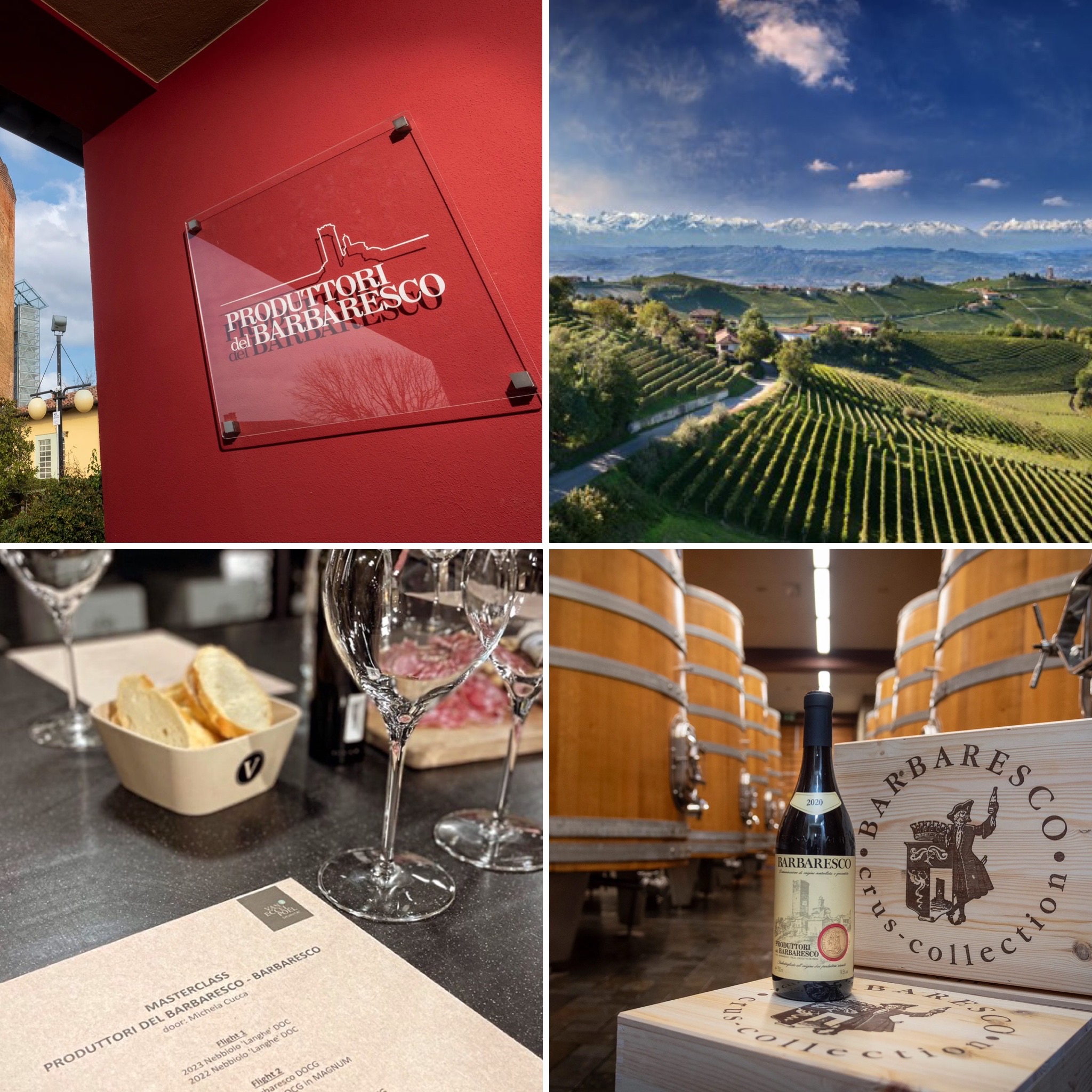Produttori del Barbaresco: Italy’s Premier Cooperative Winery.
Nestled beneath Van Eccelpoel’s food market in Herentals, Belgium, lies a hidden gem for wine enthusiasts: a cellar stocked with some of the world’s finest wines. This remarkable venue recently hosted an exclusive masterclass spotlighting the wines of Produttori del Barbaresco, one of Italy’s most esteemed cooperative wineries.
The event was led by Michela Cucca, the winery’s sales and marketing representative, who journeyed to Herentals to present a curated selection of wines. Each bottle showcased the estate’s rich heritage and dedication to crafting exceptional Barbaresco wines.
Cantina Sociale
Produttori del Barbaresco is a cooperative winery, and its history is inseparably linked to the origins of the Barbaresco wine region itself.
Twenty years ago, Produttori’s wines were the first Piedmont wines to be imported by Van Eccelpoel. Initially, the word “cooperative” raised some doubts, but quickly turned to confidence once the quality of the wines was tasted. Today, the relationship between the producer and the importer has developed into a strong partnership.
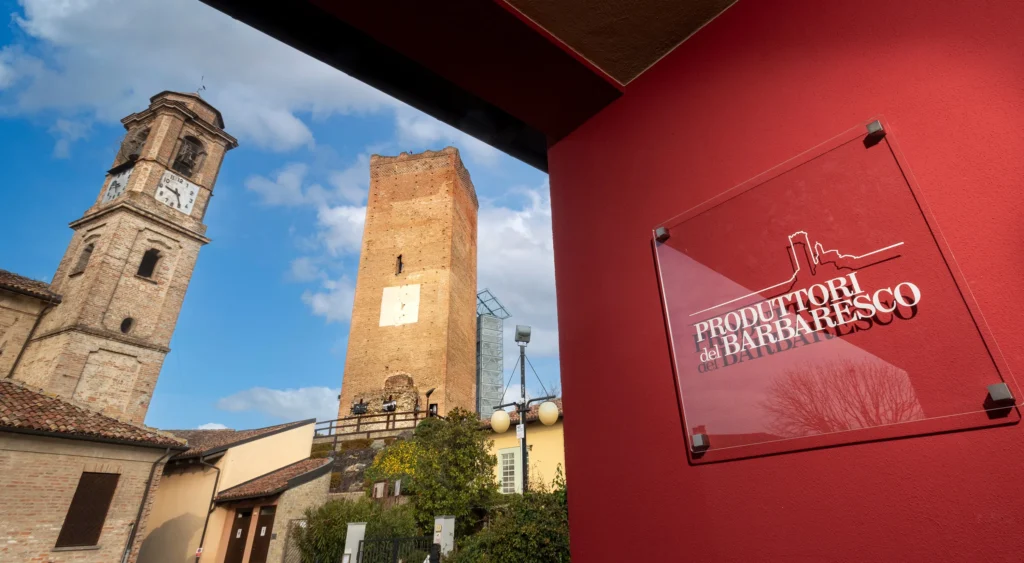
There is little information about a wine specifically called Barbaresco before 1894. It is generally assumed that most Nebbiolo grapes from Barbaresco ended up in Barolo during this period.
However, Barbaresco was already known for the quality of its Nebbiolo, both the grape and the wine, as evidenced by various documents.
An early mention from 1799 describes how General De Melas ordered the municipality of Barbaresco to deliver a cask (carrà) of 600 liters of Nebbiolo to the camp, after a military victory. Another significant mention appears in Lorenzo Fantini’s Monografia, published in 1895: ‘Next to Barolo … is Barbaresco, also made with Nebbiolo. It has the same alcohol potential as Barolo, but a bouquet that is quite different, that some would say is more refined.’
The true rise of Barbaresco is entirely due to Domizio Cavazza, known as the ‘Father of Barbaresco’. Cavazza was the founder and first director of the prestigious ‘Scuola Enologica di Alba’ (the Alba Winemaking School). Rather than settling in Alba or Barolo after his studies and travels, Cavazza surprised everyone by establishing himself in Barbaresco.
In 1886, Cavazza purchased his first property in Barbaresco. He immediately began cultivating the vineyards with Nebbiolo using advanced techniques he had learned at the University of Milan and during his stays in France and in the wine regions of Barolo and Barbaresco.
Understanding the importance of collaboration among local producers to elevate quality, Cavazza founded the Cantina Sociale di Barbaresco in 1894 together with a group initially composed of nine growers.
He acquired the Barbaresco castle, expanded its cellars, and equipped them with the necessary equipment for producing high-quality wines. In 1894, the united producers crafted the first wines officially labelled as Barbaresco.
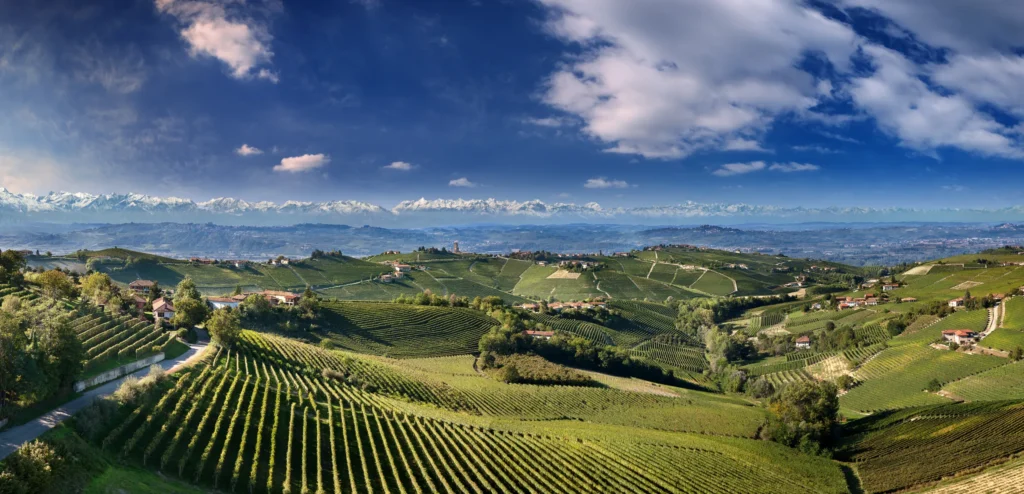
Challenges and Revival
After Cavazza’s death in 1913, the Cantine fell into decline. Under Mussolini’s fascist regime, the cooperative was closed in the 1920s. Viticulture was no longer a priority; grain and other food crops had to be cultivated. The fact that the soil was not well-suited for this led to failed harvests, which only worsened the situation for the inhabitants.
After the Second World War, while much of Europe began to recover, the Langhe region lagged behind. The area remained one of the poorest in Europe, and farmers lacked the resources to replant their vineyards.
This uncertainty drove many to abandon the countryside for cities. Working in the factories of Turin or Alba, with more comfortable living conditions and a steady monthly income, was preferable to toiling in all weather conditions in the vineyards.
Don Fiorino Marengo
In 1958, Don Fiorino Marengo, priest of Barbaresco, realized that there would soon be no parish left in Barbaresco if local families continued their exodus to Turin and Alba. Don Fiorino gathered nineteen grape growers and convinced them that it was time to revive the village cooperative. Together, they founded Produttori del Barbaresco, following in the footsteps of Cavazza half a century earlier.
The first harvest was vinified in the priest’s courtyard, and its sale yielded excellent profits, especially compared to what would have been earned from selling the grapes, as had been the practice up until then.
From the very beginning, three rules were paramount:
- Only Nebbiolo could be cultivated;
- All the production from each grower had to be delivered to the cooperative;
- Growers were paid according to the quality of their grapes, not the quantity.
Choosing the challenging Nebbiolo grape was certainly not an easy decision in those early days. Other wine regions at the time were opting for higher-yielding grape varieties, with quality not being the primary concern. The climate was also much cooler then, resulting in wines with even higher acidity than today, and managing the tannin structure had not yet been fully mastered. However, since each grape grower also became co-owner of the winery, it was an enticing opportunity to get involved.
These efforts paid off, and Produttori del Barbaresco not only became one of the best and most respected cooperative wineries in Italy, but it also inspired more landowners in Barbaresco to return to their vineyards and to focus on producing high-quality wine.
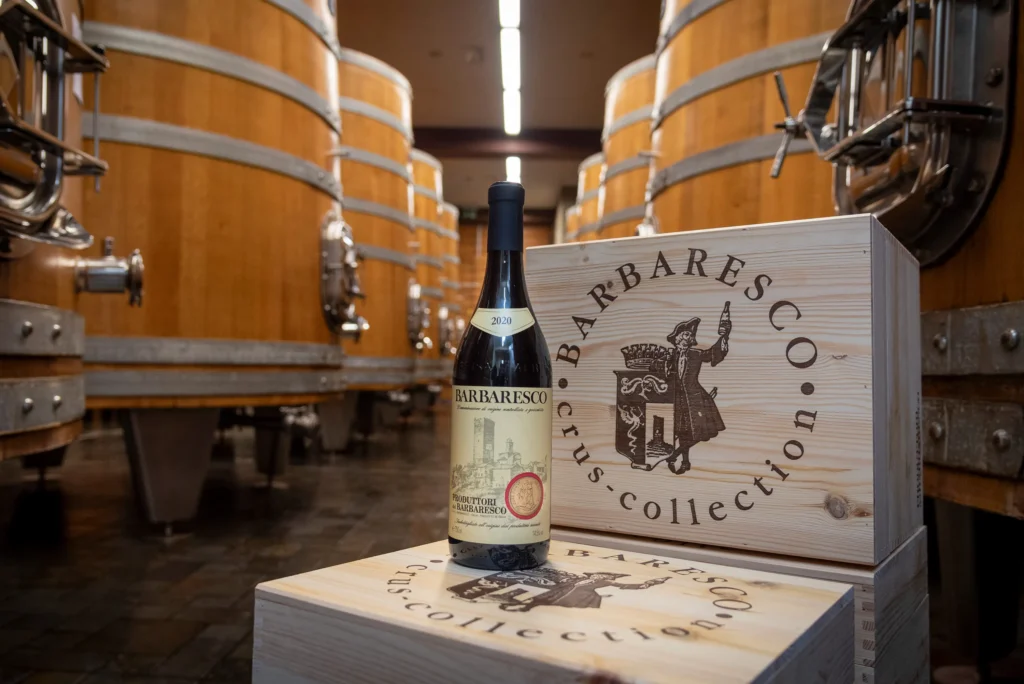
Produttori del Barbaresco Today
Currently, 54 winegrowers are active within Produttori del Barbaresco. The company is led by Managing Director Aldo Vacca. Vacca’s great-grandfather was one of the original nine members who, together with Cavazza, founded the Cantine Sociale in 1894. Together with a board of nine cooperators, elected every three years, Vacca manages 118 hectares of vineyards.
They were assisted by Gianni Testa, winemaker employed since 1986. Sadly, Gianni passed away in October 2024, after a brief retirement which he had enjoyed since 2023. Fabio Accomasso is currently the winemaker, while Lyupcho Bekarsi oversees cellar operations.
All the cooperative’s vineyards are situated in premium locations (MGA – Menzione Geografiche Aggiuntive, or Cru) around the village of Barbaresco: Asili, Rabajà, Pora, Montestefano, Ovello, Pajè, Montefico, Muncagota, and Rio Sordo.
Sant’Agata marl, composed of gray silty clayey marl, characterizes the soil, but there are many subtle differences between the various locations. The numerous small valleys draining toward the Tanaro river create a multitude of orientations, water management, UV radiation, sunshine, and temperature influences, which contribute to the uniqueness of each cru.
By law, Barbaresco wines must be made from 100% Nebbiolo. The wine must age for at least 26 months, of which nine months in wood. Barbaresco Riserva remains in the cellar for 50 months, also with a required minimum of nine months in barrel. Produttori del Barbaresco adheres a very classic approach here: no barriques, but large French and Slavonian oak barrels of 25, 50, and 75 hectoliterss.
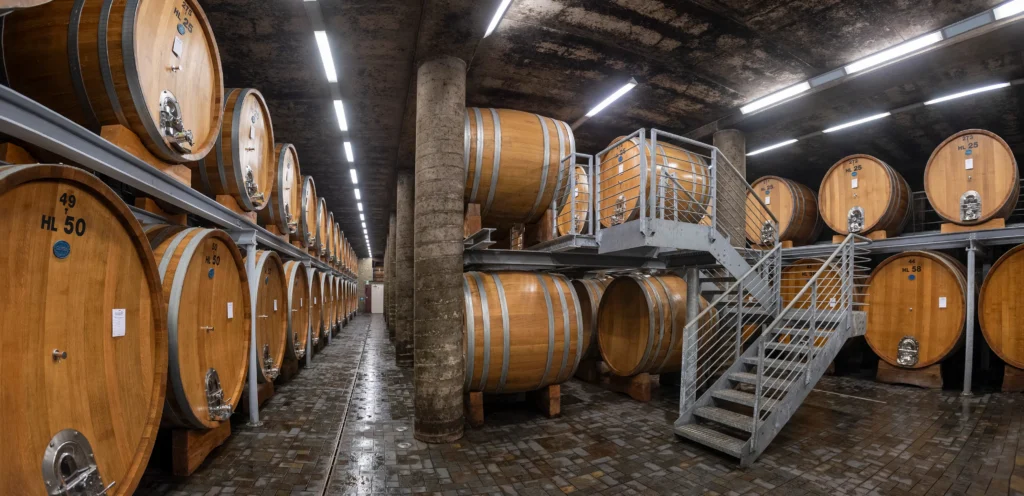
The Wines of Produttori del Barbaresco
Michela Cucca presented nine wines, served two by two. This provided a clear picture of what the cooperative stands for. In short: high quality, wines with personality, and great ageing potential.
Flight 1: 2023 and 2022 Langhe Nebbiolo (Langhe Nebbiolo DOC)
Although the Langhe Nebbiolo DOC regulations allow for up to 15% of other grape varieties, Produttori del Barbaresco uses only Nebbiolo. With just four to five months of ageing, these wines cannot be labeled as Barbaresco DOCG. However, the shorter ageing period allows the company to bring the wine to market more quickly, making these wines economically significant for them.
2023 was generally considered an average year, neither very warm nor very dry, except for a short heatwave that temporarily halted growth but allowed the grapes to reach full ripeness later.
In contrast, 2022 saw winemakers concerned about persistent drought that began a year earlier. Nevertheless, the old vines managed to cope. The harvest in 2022 started two weeks earlier than the 2023 vintage.
It’s remarkable how two wines just one vintage apart can be so different.
Langhe Nebbiolo 2023 is a playful young lady in the glass: aromas of red cherry, red berries, and bay leaf continue into the palate, where the bright acidity and light tannins create a pleasant wine.
Langhe Nebbiolo 2022 shows itself as robust and unyielding, and is not yet accessible. Minerality and florality characterize the nose, along with strawberry and red cherry. On the palate, immediate firm tannins dominate the underlying dark forest fruits. The finish reveals dark blackberries and still-firm tannins. This stubborn youth awaits further ageing to develop into a noble wine.
We reward the 2023 with a 91-point DWA score and the 2022 with a 91–92-point DWA score.
Flight 2: 2021 and 2017 Barbaresco (Barbaresco DOCG)
The generic Barbaresco is Produttori’s flagship wine, representing the cooperative’s calling card each year. Traditional winemaking methods involve two years of ageing in large casks and another year in bottle. The bottles are only released in the third year after harvest, meaning the 2021 vintage has just been released.
Michela describes 2021 as a ‘perfect year.’ The wines have a promising future and can withstand comparisons with the great 2016 vintage. In the other glass came the Barbaresco 2017 served from magnum. Late frost in April caused a 30 to 50 percent loss in fruit. Drought and a heat wave led to rapid grape ripening.
With the Barbaresco 2021 we get a still-young cherry-red wine in the glass. It is aromatic and floral, with notes of roses, cherries, strawberries, and lemon peel. The dense mouthfeel with forest fruits, fine acidity, and ripe tannins contribute to a rounded complexity.
Barbaresco 2017 already shows some color evolution towards garnet red. The wine takes us deep into a warm summer forest, where the fruit is ripe and the flowers and forest floor emit a sultry scent. A bouquet of flowers, tar and underwood, balsamic notes, and green herbs emerge. Slightly sweeter impressions, lots of juiciness, round and soft tannins, and supporting freshness. The citrus in the finish is notable, creating balance with the dark sweet fruit.
Four years apart, two distinct characters, two very beautiful wines. We award both wines with a 92-point DWA score.
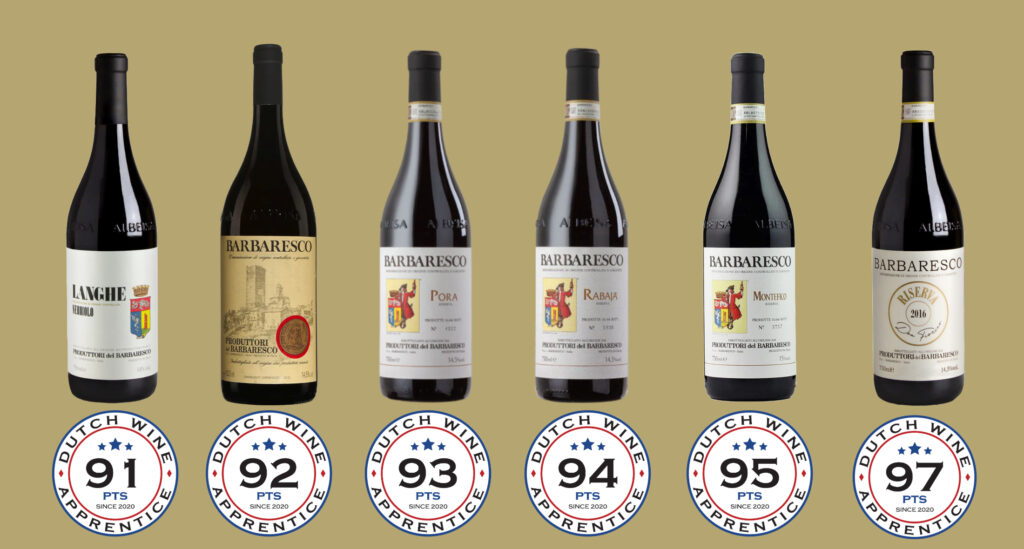
The Single Vineyard Wines (MGA’s or Cru’s) of Produttori del Barbaresco
All vineyards of the cooperative members are located in one or more of the nine Menzioni Geografiche Aggiuntive around the village of Barbaresco.
Produttori del Barbaresco has strict conditions for producing wines with MGA designation. To avoid internal competition between member winegrowers, it was decided to bottle wines with this designation only if all nine crus can be released, meaning they should all achieve the high quality and typicity they strive for. If even one cru fails to meet these standards, all the grapes are blended into the generic Barbaresco. This happened for example in 2010, 2012, and 2018.
When MGA’s are produced, the vineyard owner is named on the back label as a tribute. At Produttori, MGA’s are always made as Riserva, with three years of oak ageing and two years of bottle ageing. The wines are thus released only in the fifth year after harvest.
Michela presents two MGA’s side by side to demonstrate the difference in vineyards within the small area.
Flight 3: 2019 Pora and 2019 Rabajà 2019 (Barbaresco Riserva DOCG)
Pora is situated in a small side valley opening onto the Tanaro river. It’s always slightly cooler there, and the river provides humidity. The wines are typically more elegant. Rabajà lies further from the river, and with more clay in the soil and a warmer exposure, wines with more power emerge from here.
Pora 2019 is a like a ballerina. Nebbiolo with typical dried rose petals, red cherries, candied fruit, and balsamic notes. Noble tannins support ripe strawberries and forest fruits. The acidity keeps everything elegant and light-footed. In the finish, the influence of oak emerges, with hints of coffee and caramel.
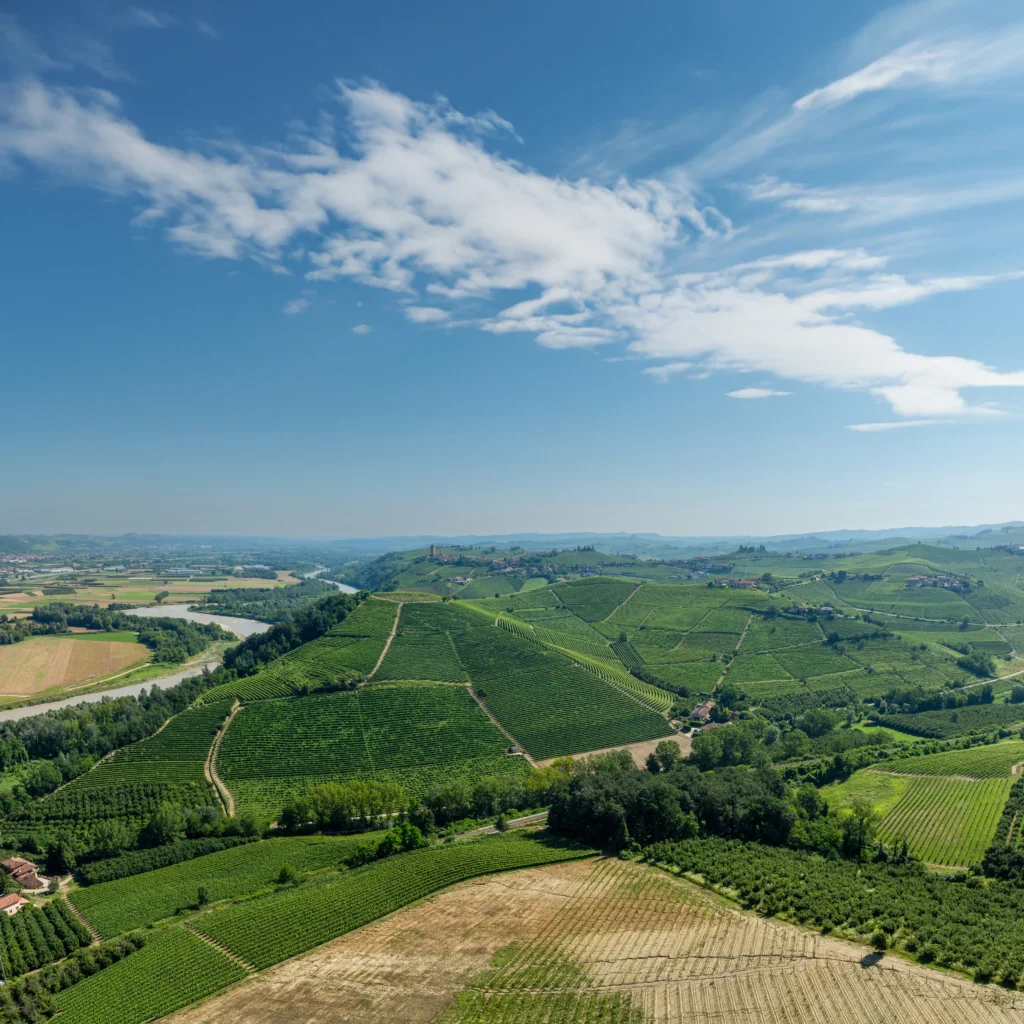
Rabajà 2019 appears darker in the glass, and here mocha and coffee are present in the first nose, along with balsamic notes, black cherries, and rose petal. The palate is intense and concentrated, with flavors of black cherries and blackberries. The ripe, noble tannins are pronounced yet balanced within the dense texture. The long finish lingers with dark cherries, vanilla, and caramel. This is a powerful wine!
We reward the 2019 Pora with a 92–93-point DWA score and the 2019 Rabajà with a 94-point DWA score.
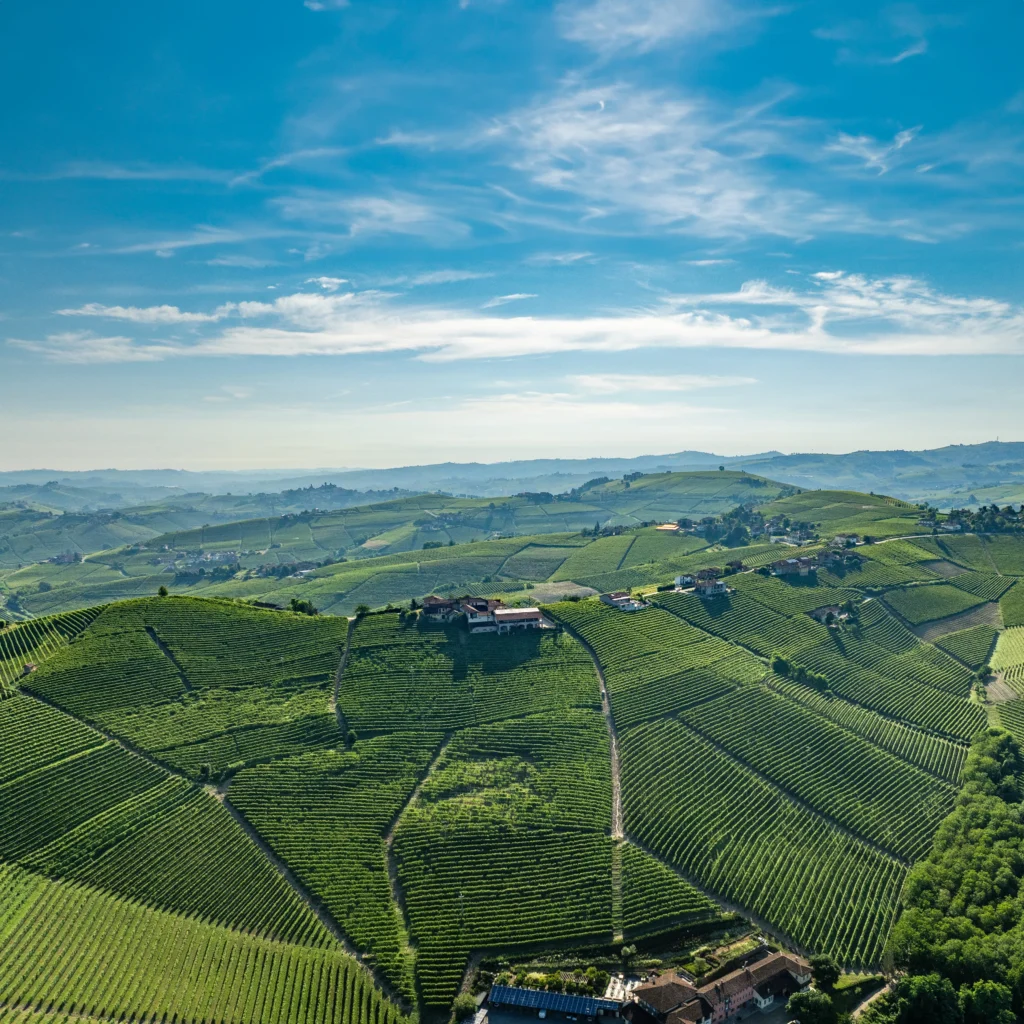
Flight 4: 2017 and 2007 Montefico (Barbaresco Riserva DOCG)
Two wines with a decade of age difference, yet both showcase the unique character of Montefico, a vineyard that consistently produces exceptional Nebbiolo.
The Montefico vineyard faces due south. The summer heat is tempered in the fresh morning hours by a cool northerly wind that occasionally blows from the Tanaro river into the narrow valley. The soil contains a higher proportion of limestone. In 2017, yields were 30% lower due to hail and late frost in spring and extreme heat in the summer months. In 2007, drought also reduced yields slightly, but the early harvest produced fruit described as “good” to “near perfect”.
Montefico 2017 has floral notes and red and blue berries along with leather, tobacco, incense, and fine spices on the nose. Everything in the mouth feels refined: the acidity precise, the tannins supporting without dominating, and the fruit ripe and still young. The lightness is deceptive, as there is much substance and complexity, which continues into the long finish, with coffee grounds, prominent ripe tannins, and dried black fruit. Great wine!
We award this wine with a 94-point DWA score.
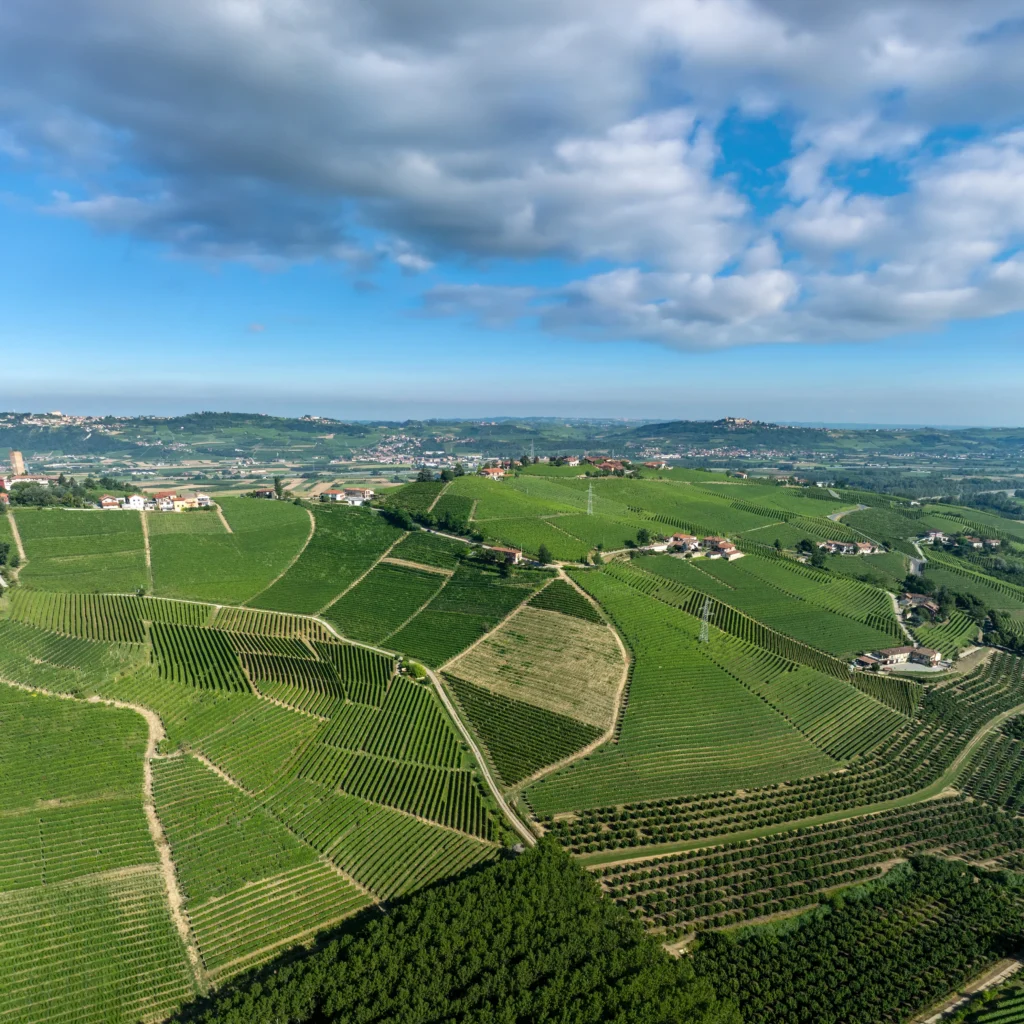
Montefico 2007 shows color evolution towards brick red. The nose offers savory aromas of meatiness, tobacco, iron, black cherries, and ripe blackberries. After swirling, tertiary notes of truffle and underwood, coffee, leather, and game emerge. The initially sweet attack with very ripe black cherries and blackberries is followed by a balancing acidity that provides freshness and structure. The tannins are fully integrated and almost imperceptible. A juicy texture invites for another sip, and the lingering finish is round and soft. This contemplative wine is pure brilliance!
We award this wine with a 95-point DWA score.
Flight 5: 2016 Don Fiorino (Barbaresco Riserva DOCG)
When conditions align perfectly, as in the outstanding 2016 vintage, Produttori del Barbaresco produces a unique cuvée, dedicated to the cooperative’s founder. It’s a super blend of the best plots within all nine cru’s. Approximately 50% of the harvest from each plot is selected for this wine, the other half is used for the single vineyard wines. This super blend honors the old tradition of using grapes from different vineyards to obtain the best possible wine.
Don Fiorino Riserva ages for thirty months in large casks and is further aged for four years in bottle. As of now, the 2016 is the only vintage produced, although the 2021 vintage may potentially be the second Don Fiorino selected.
2016 Don Fiorino
A brick-orange tint hints at the extensive barrel and bottle ageing. Freshly picked forest fruits and wild strawberries welcome you on the nose. The smoky minerality with iron and blood, white pepper, bay leaf, and mint evolves into pronounced floral and ethereal spiciness. Full and creamy on the palate, complex and elegant, with meaty depth and finesse. Black cherries, black blueberries, coffee and mocha, chocolate, and caramel vie for your attention. The festive experience continues into the long finish, where firm yet ripe tannin will ensure a great future.
This is a monumental wine. The finest Barbaresco I have ever had the pleasure of tasting.
We award this wine with a 97-point DWA score
Produttori del Barbaresco: A Masterclass in Tradition, Innovation, and Uncompromising Quality
Produttori del Barbaresco, widely regarded as Italy’s finest cooperative winery, demonstrates with this tasting what is possible when winegrowers are given responsibility, find recognition, and a shared goal for uncompromising quality. Produttori balances tradition with innovation, offering wines that express both the typicity of Barbaresco and the unique character of each vineyard.
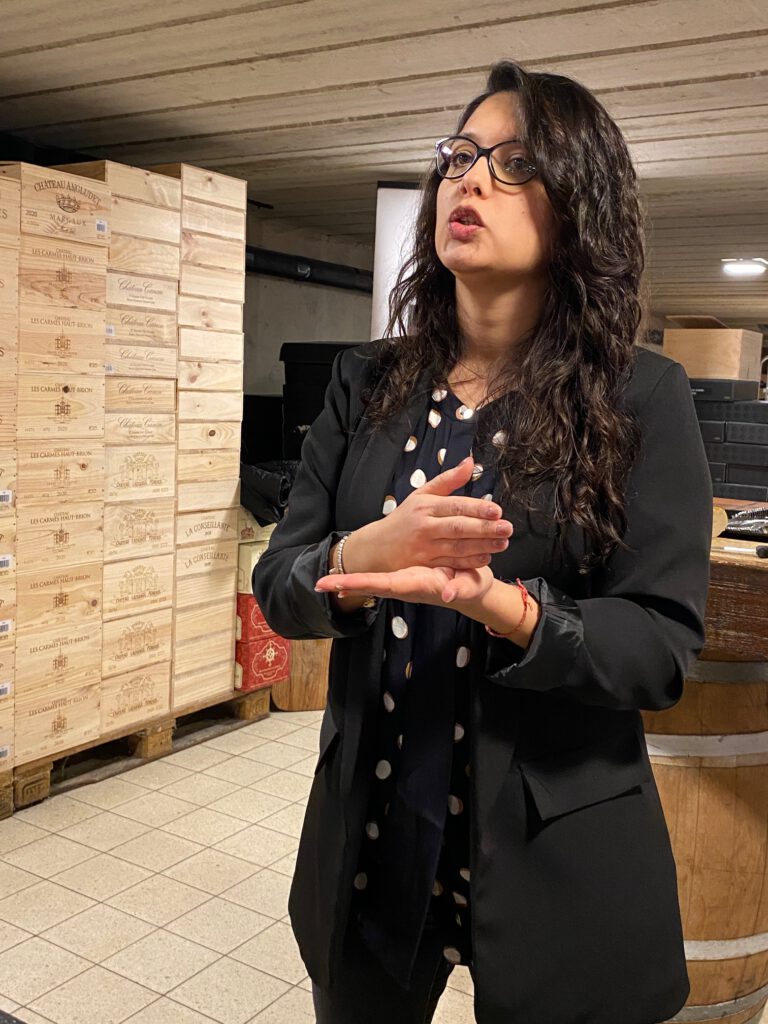
This exceptional tasting showcased the quality and diversity of their portfolio, from the approachable Langhe Nebbiolo to the elegant or powerful single vineyard Riserva bottlings and the monumental masterpiece Don Fiorino. Each wine underscored the dedication to precision and perfection that characterizes the philosophy of Produttori del Barbaresco.
This article is written by our own Marc Roovers. A heartfelt thanks to Koen, Sean, Senne, and the entire team at Van Eccelpoel Wines, the Belgian importer of Produttori del Barbaresco, for organizing this exceptional tasting and for the fine dishes that beautifully complemented the wines.
This made it a truly unforgettable experience. Also, sincere thanks to Michela Cucca, whose passion and knowledge elevated the masterclass to a high level.

